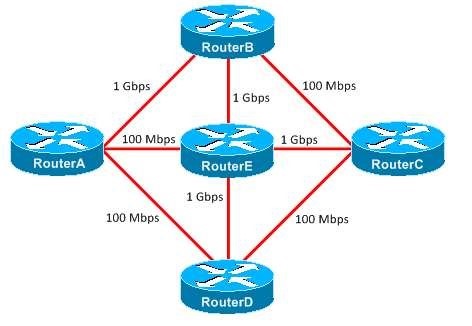You administer the OSPF network shown in the diagram above. All interface and OSPF parameters retain their default values.
Which of the following statements is true regarding the path that packets from RouterA will follow to reach RouterC? (Select the best answer.)
A. All packets will flow from RouterA to RouterB to RouterC.
B. All packets will flow from RouterA to RouterD to RouterC.
C. All packets will flow from RouterA to RouterE to RouterC.
D. All packets will flow from RouterA to RouterB to RouterE to RouterC.
E. Equalcost load balancing will distribute packets evenly between the following two paths:- RouterA to RouterE to RouterC- RouterA to RouterB to RouterC
F. Equalcost load balancing will distribute packets evenly between the following two paths:- RouterA to RouterE to RouterC- RouterA to RouterD to RouterC
G. Equalcost load balancing will distribute packets evenly among the following three paths:- RouterA to RouterB to RouterC- RouterA toRouterE to RouterC- RouterA to RouterD to RouterC
H. Unequalcost load balancing will distribute packets unevenly based on bandwidth among all possible paths.
Explanation:
In this scenario, equalcost load balancing will distribute packets evenly among the following three paths:
– RouterA to RouterB to RouterC
– RouterA to RouterE to RouterC
– RouterA to RouterD to RouterC
An Open Shortest Path First (OSPF) routing process uses a cost metric that is based on the bandwidth of an interface relative to a reference bandwidth. The formula to determine the cost of an interface is as follows:
cost = reference bandwidth / interface bandwidth
The default reference bandwidth is 100 Mbps. If a bandwidth has not been configured on an interface, the OSPF process will use the default value for the interface type. The minimum supported cost for an OSPF interface is 1, and any values that calculate to less than 1 are rounded up to 1. Therefore, any link with an interface bandwidth greater than or equal to 100Mbps will result in a cost of 1 by default. As a result, the 100Mbps FastEthernet links and the 1Gbps GigabitEthernet links in this scenario will all have a cost of 1.
An OSPF process uses cost values to generate its shortest path first (SPF) tree and then to determine the optimal routes to all known networks. Because the minimum cost value is 1, the reference bandwidth should be a value greater than or equal to the bandwidth of the fastest routed link in the administrative domain. If the reference bandwidth is less than the fastest routed link on the network, a situation can arise where the cost of two interfaces is the same even though their link speeds are different. For example, in this scenario, the cost of every link has a value of 1. Because all links appear to have the same cost, the OSPF routing process cannot distinguish between the FastEthernet and GigabitEthernet links in the network. When an OSPF routing process is presented with multiple routes of the same cost, equalcost load balancing is used to distribute packets evenly among the available paths. This distribution will cause some packets in this scenario to take suboptimal routes to their destinations.
You can issue the autocost command from router configuration mode to change the reference bandwidth for an OSPF routing process. The syntax for the autocost command is autocost referencebandwidth refbw, where refbw is an integer between 1 and 4294967 and is expressed as a value in megabits per second. Alternatively, you can manually configure a cost at the interface level with the ip ospf cost command.
OSPF supports only equalcost load balancing; it does not support unequalcost load balancing. Enhanced Interior Gateway Routing Protocol (EIGRP) supports both equalcost and unequalcost loadbalancing.
Reference:
https://www.cisco.com/c/en/us/support/docs/ip/open-shortest-path-first-ospf/7039-1.html#t6
https://www.cisco.com/c/en/us/td/docs/ios-xml/ios/iproute_ospf/command/iro-cr-book/ospf-a1.html#wp3271966058
https://www.cisco.com/c/en/us/td/docs/ios-xml/ios/iproute_ospf/command/iro-cr-book/ospf-a1.html#wp4045850100


